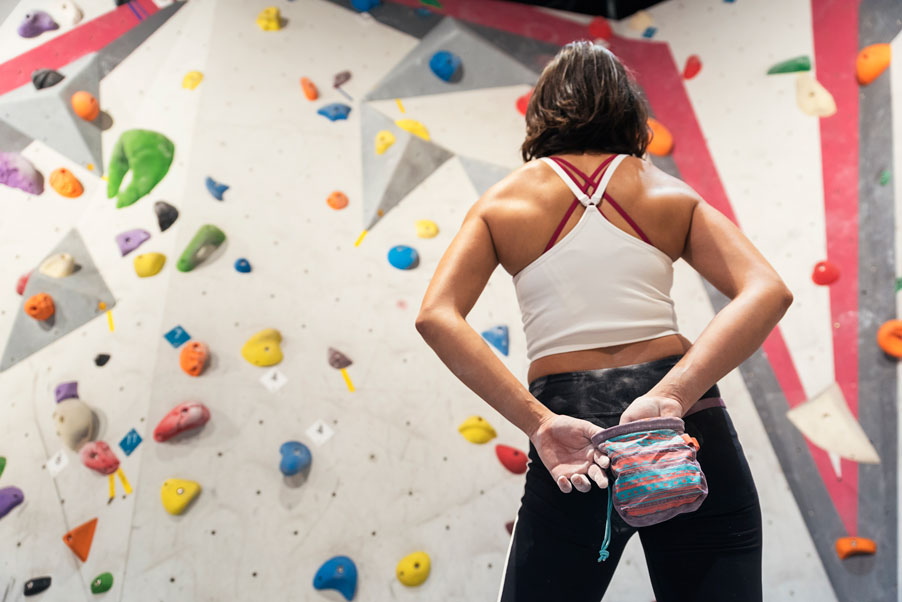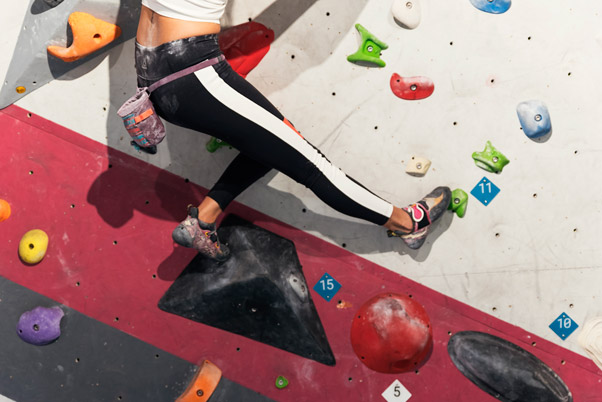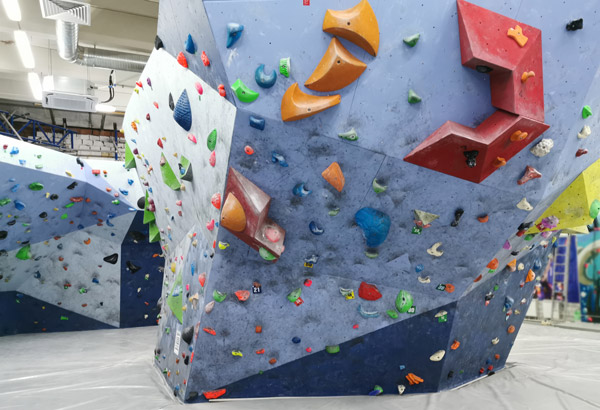Have you recently discovered the marvelous sport that is bouldering? A question you might have is: “how much can you use the bouldering wall?” It can get confusing which parts are considered ‘in’ and which parts are considered ‘cheating’.
You really don’t want to look like a gumby, right?
Most bouldering gyms aren’t great at passing on information. So new climbers are often left confused and unsure of what to do.
What are the rules? Is every part of the bouldering wall ‘in’, or are some things not allowed?
📚 This article is part of our Bouldering Beginners Guide.

What can I touch during a boulder problem?
A usual bouldering problem will have a colored route going all the way to the top of the wall. You are allowed to use any foot and hand holds in the color matching your problem. You are allowed to use these matching holds in any way you see fit. Meaning you are allowed to grab footholds with your hands, stand on the handholds, and use them for toe or heel hooking.
You are also allowed to smear on the bouldering wall, smear on the volumes, grab an arete (corner), touch the wall, push off the wall, and so on.
When route setters are setting a boulder problem, they are considering the wall use the wall as part of their beta. So everything you encounter along the route is considered ‘in’.
The only thing most climbing gyms don’t allow is to touch the top of the wall unless they require you to finish that way. The top of the wall is considered cheating, everything else isn’t.
You can almost be certain of that. That being said, what is included, is still dependent from climbing gym to gym.
Some climbing gyms may have old-school walls and have different rules about what is considered part of the route. And some other climbing gyms have rules such as “you cannot smear off a volume if it doesn’t have a matching colored hold.”
But for the most part, you can assume everything is considered part of the wall unless stated otherwise. Sometimes a boulder problem may have a sign that reads: “don’t use the volumes”. But that’s straightforward enough.
If the problem was intended to be used without touching certain elements but this wasn’t indicated anywhere, that is the route setters’ mistake and not yours.
To recap…
What you are allowed to touch during a boulder problem:
- Any matching hand and foot holds
- Smear (push) off the wall
- Use the volumes in whatever way you see fit
- Touch and push off the wall
- Grab the corners (arete) of the wall
You are not allowed to:
- Touch the top of the wall (unless it’s the finish hold)
- Touch other colored holds
Can I touch the volumes?
Volumes are the heroes of a modern bouldering gym. These big wooden, geometric structures allow route setters to change the wall completely and make countless different boulder problems.

So if a boulder problem has a volume in its route, you can be damn sure that the setter thought about that and included it in the beta. This is almost always the case.
In many cases, you have to use the volume, and not using it would make the problem almost impossible or at least bump it up a bouldering grade or two.
If a volume is not included, it will be stated on the problem.
Heads up: some climbing gyms have a rule that they don’t allow the use of volumes if the volume doesn’t include a hold matching the color of your route. This is rare though and if this is the case, it will usually be displayed somewhere.
How do I properly finish my boulder problem?
How you top off of your boulder problem, is where most climbing gyms differ.
Some bouldering walls require you to top off by matching on the last hold while others require you to touch the top of the wall with both your hands.
The former is the most common way to finish (or send) a boulder problem, the latter tends to be a bit more rare but still occurs at some bouldering walls.
Oftentimes, the last hold will be marked with either tape or a sign that says “top”. In this case, you can be certain that you finish your problem by matching the last hold.
Other times, the top of the wall might be taped, indicating that you should finish by grabbing the top of the wall with both hands.
If there is no indication at all, you will have to ask a staff member or a fellow climber how you should properly top off your route.
How long can I ‘hog’ a bouldering wall?
Bouldering walls have many different routes on each section of the wall. This is the only way to set hundreds of boulder problems in a small climbing gym.
So while you are attempting a boulder problem, another climber might be waiting for you to finish and hop on the wall themselves.
This is why it’s important never to hog the bouldering wall. Once you send your problem, you should look behind you and see if anyone is waiting before hopping back on the wall.
If no one is eyeing the wall, it’s yours. If you see someone eyeing it, move away from the wall and let them have a go. This is a common courtesy at a climbing wall.
If you are unsure, just ask.
Conclusion
Route setters are aware of the wall when they are setting a boulder problem, so they definitely thought about the volumes, corners, and other features before setting the problem. This means these elements are most likely part of the beta, and thus are considered part of the route.
If a certain part of the bouldering wall is not included, it should be stated somewhere. So grab that corner, smear on that volume and send your project.
📚 Eager for more? Read our Bouldering Beginners Guide.
Continue reading
More articles like this
- Indoor Bouldering Basics: intro to gym climbing
- Tips for short climbers
- Complete Guide to Bouldering Grades (& conversions)
- How to start and finish a boulder problem
- Can I get abs from climbing?
- Bouldering vs rock climbing
- How often you should go bouldering per week
- Why bouldering is a good full-body workout
- Climbing 101: what is cutting feet?
- How long does it take to progress in bouldering?
- How much does it cost to start bouldering?
- What to wear indoor bouldering
- How much of a bouldering wall can you use?
- Should climbing shoes hurt?
- How many climbing shoes do you really need?
- Yoga for climbers
- Core workout for climbers
